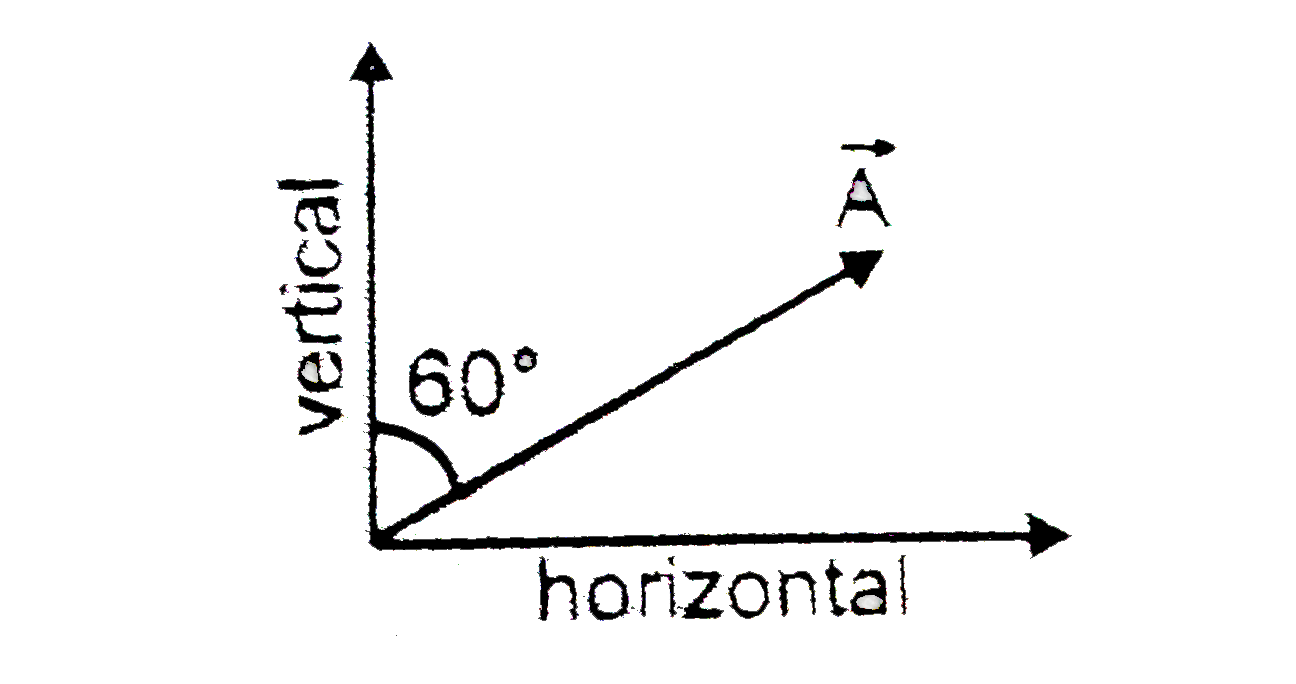An aeroplane takes off at an angle of 60∘ to the vertical .If the component of velocity along the vertical is 250km/hr, calculate its
(i) actual velocity and
(ii) horizontal component of velocity.
To solve the problem step by step, we will break it down into two parts as per the question.
Given:
- Angle of takeoff with the vertical, θ=60∘
- Vertical component of velocity, Vy=250km/hr
Part (i): Calculate the Actual Velocity
1. Understanding the relationship between components and actual velocity:
The vertical component of the velocity can be expressed in terms of the actual velocity V and the angle θ:
Vy=Vcos(60∘)
2. Substituting the known values:
We know that Vy=250km/hr and cos(60∘)=12:
250=V⋅12
3. Solving for the actual velocity V:
To find V, we can rearrange the equation:
V=250⋅2=500km/hr
Part (ii): Calculate the Horizontal Component of Velocity
1. Using the relationship for horizontal component:
The horizontal component of the velocity can be expressed as:
Vx=Vsin(60∘)
2. Substituting the actual velocity and the sine value:
We already found V=500km/hr and sin(60∘)=√32:
Vx=500⋅√32
3. Calculating Vx:
Vx=250√3km/hr
Final Answers:
- (i) Actual velocity V=500km/hr
- (ii) Horizontal component of velocity Vx=250√3km/hr
---
- Angle of takeoff with the vertical, θ=60∘
- Vertical component of velocity, Vy=250km/hr
The vertical component of the velocity can be expressed in terms of the actual velocity V and the angle θ:
Vy=Vcos(60∘)
We know that Vy=250km/hr and cos(60∘)=12:
250=V⋅12
To find V, we can rearrange the equation:
V=250⋅2=500km/hr
The horizontal component of the velocity can be expressed as:
Vx=Vsin(60∘)
We already found V=500km/hr and sin(60∘)=√32:
Vx=500⋅√32
Vx=250√3km/hr
- (i) Actual velocity V=500km/hr
- (ii) Horizontal component of velocity Vx=250√3km/hr
Topper's Solved these Questions
- MOTION IN A PLANE BOOK - MODERN PUBLICATIONCHAPTER - MOTION IN A PLANE EXERCISE - COMPETITION FILE OBJECTIVE TYPE QUESTIONS (A. Multiple Choice Questions)
30 Videos
- MOTION IN A PLANE BOOK - MODERN PUBLICATIONCHAPTER - MOTION IN A PLANE EXERCISE - COMPETITION FILE OBJECTIVE TYPE QUESTIONS (B. Multiple Choice Questions)
38 Videos
- MOTION IN A PLANE BOOK - MODERN PUBLICATIONCHAPTER - MOTION IN A PLANE EXERCISE - Revision Exercises (Long Answer Question)
6 Videos
- MECHANICAL PROPERTIES OF FLUIDSBOOK - MODERN PUBLICATIONCHAPTER - MECHANICAL PROPERTIES OF FLUIDSEXERCISE - Chapter Practise Test
16 Videos
- MOTION IN A STRAIGHT LINE BOOK - MODERN PUBLICATIONCHAPTER - MOTION IN A STRAIGHT LINE EXERCISE - CHAPTER PRACTICE TEST
16 Videos
Similar Questions
An aeroplane taked off at an angle of 30∘ to the horizontal. If the component of its velocity along the horizontal is 200kmh−1, what is its actual velocity ? Also find the vertical component of its velocity.
View SolutionAn aeroplane takes off at angle of 30∘ to the horizontal. If the component of its velocity along the horizontal is 250kmh−1, what is the actual velocity ? Find also the vertical component of the velocity.
View Solution
Knowledge Check
An aeroplane takes off at an angle of 60∘ to the horizontal. If the velocity of the plane is 200kmh−1,calculate its horizontal and vertical component of its velocity (in kmh−1) .
Avx=50 , vy=10√3Bvx=50√3 , vy=100√3Cvx=100√3 , vy=100√3Dvx=100 , vy=100√3In the Q.23, the vertical component of the velocity is:-
A25m/sB40m/sC12.5m/sD31.25m/s
An aeroplane takes off at an angle or 30∘ to the horizontal. If the component of its velocity along the horizontal is 240kmh−1. What is the actual velocity. ? Also find the vertical component of its velocity ?
View SolutionAn aeroplane takes off at an angle of 30∘ to the horizontal. If the velocity of the plane is 200 Km/hr, then the vertical component of its velocity is 100% (in Km/hr). Find the value of x.
View SolutionA stone is projected at an angle of 30∘ with the vertical. If the horizontal component of its velocity is 9.8m/s , calculate the maximum height attained by the stone and its horizontal range .
View SolutionA force of 4N is inclined at an angle of 60∘ from the vertical. Find out its components along horizontal and vertical directions.

View SolutionA force is inclined at an angle of 60∘ from the horizontal. If the horizontal component of the force is 40N. Calculate the vertical component.
View SolutionA force is inclined at an angle of 60∘ from the horizontal. If the horizontal component of the force is 40N,calculate the vertical component.
View Solution
